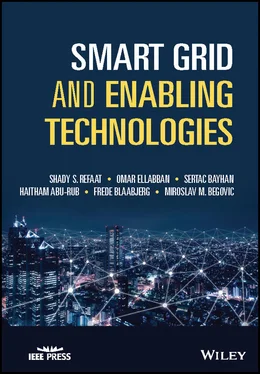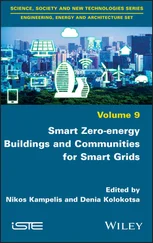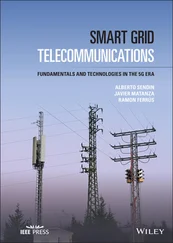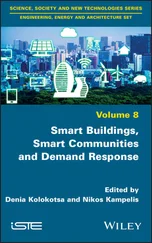Frede Blaabjerg - Smart Grid and Enabling Technologies
Здесь есть возможность читать онлайн «Frede Blaabjerg - Smart Grid and Enabling Technologies» — ознакомительный отрывок электронной книги совершенно бесплатно, а после прочтения отрывка купить полную версию. В некоторых случаях можно слушать аудио, скачать через торрент в формате fb2 и присутствует краткое содержание. Жанр: unrecognised, на английском языке. Описание произведения, (предисловие) а так же отзывы посетителей доступны на портале библиотеки ЛибКат.
- Название:Smart Grid and Enabling Technologies
- Автор:
- Жанр:
- Год:неизвестен
- ISBN:нет данных
- Рейтинг книги:3 / 5. Голосов: 1
-
Избранное:Добавить в избранное
- Отзывы:
-
Ваша оценка:
- 60
- 1
- 2
- 3
- 4
- 5
Smart Grid and Enabling Technologies: краткое содержание, описание и аннотация
Предлагаем к чтению аннотацию, описание, краткое содержание или предисловие (зависит от того, что написал сам автор книги «Smart Grid and Enabling Technologies»). Если вы не нашли необходимую информацию о книге — напишите в комментариях, мы постараемся отыскать её.
Smart Grid and Enabling Technologies
Smart Grid and Enabling Technologies
Smart Grid and Enabling Technologies — читать онлайн ознакомительный отрывок
Ниже представлен текст книги, разбитый по страницам. Система сохранения места последней прочитанной страницы, позволяет с удобством читать онлайн бесплатно книгу «Smart Grid and Enabling Technologies», без необходимости каждый раз заново искать на чём Вы остановились. Поставьте закладку, и сможете в любой момент перейти на страницу, на которой закончили чтение.
Интервал:
Закладка:
7 Chapter 7Table 7.1 ZEB definitions summary.Table 7.2 Classifying nZEBs by renewable energy supply.Table 7.3 Energy savings potential using smart technology. Ref Num [13]. Repr...Table 7.4 Renewable energy technologies applications in nZEB.Table 7.5 Classification of algorithms for building performance optimization....Table 7.6 Summary of the three optimization algorithms' performance under six...Table 7.7 A building design framework using the optimization methods as a dec...Table 7.8 Community efficiency and renewable supply hierarchy.
8 Chapter 8Table 8.1 Benefits of advanced metering infrastructure. Adapted from Ref [4].Table 8.2 Usual QoS conditions of few representative kinds of traffic in SG c...Table 8.3 Comparison between wired communication technologies. Ref [17]. Repr...Table 8.4 Comparison between wireless communication technologies. Ref [17]. R...
9 Chapter 9Table 9.1 Time latency for SG applications [26]. Reproduced with permission f...Table 9.2 Main cyber security requirements for the SG. Adapted from Ref Num [...
10 Chapter 10Table 10.1 Typical big data sources [7]. Reproduced with permission from IEEE...
11 Chapter 11Table 11.1 The properties of load‐response programs [8]. Reproduced with perm...Table 11.2 Price response program overview [8]. Reproduced with permission fr...Table 11.3 A brief description of each technique [18, 19].
12 Chapter 12Table 12.1 The core influence of SGs on electricity firms' business model inn...Table 12.2 Traditional and the smart utilities. Ref [7]. Reproduced with perm...Table 12.3 Utility‐side vs. customer‐side business model. Ref [2]. Reproduces...Table 12.4 Different prosumer‐oriented business model characteristics. Adapte...
13 Chapter 13Table 13.1 Possible enablers and barriers of end‐user engagement in SG projec...
14 Chapter 14Table 14.1 The criteria of cloud computing prospective.
15 Chapter 15Table 15.1 List of the ML‐based AI review papers for 2020.Table 15.2 Mainstream DL architectures with their advantages, limitations, an...Table 15.3 List of hybrid models for smart energy applications.Table 15.4 Comparative study of the proposed methods.Table 15.5 Comparative study of metaheuristic algorithms for SG applications.Table 15.6 Most popular error measures for regression tasks.Table 15.7 Classes of score metrics.Table 15.8 Short‐term SG‐based AI applications.Table 15.9 Medium‐term SG‐based AI applications.Table 15.10 Long‐term SG‐based AI applications.
16 Chapter 17Table 17.1 Overview of standards.
List of Illustrations
1 Chapter 1 Figure 1.1 The fundamentals of electric power system. Adapted from Ref Num [... Figure 1.2 Selection of rated voltage for three‐phase AC transmission line. ... Figure 1.3 Main types used in electric power distribution, (a) Redial feeder... Figure 1.4 Traditional power grid. Figure 1.5 The conceptual model of SG framework. Ref [18]. Reproduced with p... Figure 1.6 SG components. Figure 1.7 Main key technology areas of smart grid. Figure 1.8 Distributed energy resources paradigm in smart grid. Ref [20]. Re... Figure 1.9 The distributed energy storage system. Figure 1.10 Schematic diagram communication infrastructure for the SG. Figure 1.11 Customer engagement demand side management spending by region, 2... Figure 1.12 Distributed operation architecture with two levels. Figure 1.13 Decentralized operation architecture. Figure 1.14 Local operation architecture. Figure 1.15 Central operation architecture. Figure 1.16 Classification of DR. Figure 1.17 The difference between the conventional power grid and smart gri... Figure 1.18 Three trends of the grid edge transformation. Figure 1.19 Technologies for the evolution of the SG. Figure 1.20 Fishbone diagram showing gaps. Figure 1.21 The main stages for achieving grid modernization. Figure 1.22 SG role in the electricity power sector. Figure 1.23 SG investment. Adapted from [89]. Figure 1.24 SG costs Ref [90]. Reproduced with permission from EPRI (Electri...
2 Chapter 2 Figure 2.1 Flowchart of the common renewable energy sources. Figure 2.2 Renewable energy resources theoretical potential. Figure 2.3 Total renewable power installed capacity (GW), including its annu... Figure 2.4 Main features of the bioenergy energy technology. Adapted from [1... Figure 2.5 Bioenergy conversion processes for different end products. Figure 2.6 Global biomass cumulative installed capacity, 2000–2013. Ref Num ... Figure 2.7 Biomass installed capacity for energy systems (2010–2025). Ref Nu... Figure 2.8 Cumulative installed geothermal generating capacity by top 10 cou... Figure 2.9 Global geothermal installed capacity from 1950 up to 2019 and its... Figure 2.10 Hydropower generation by top 10 countries in 2019. Adapted from ... Figure 2.11 The evolution of world hydropower generation since 1980. Figure 2.12 Global ocean power capacity forecasting. Figure 2.13 Global integrated solar PV capacity from 2000 to 2019. Figure 2.14 Solar PV global capacity by top 10 countries in 2019. Figure 2.15 PV shares of grid‐connected (distributed and centralized) and of... Figure 2.16 Global installed concentrating solar power capacity, 2000–2019.... Figure 2.17 Concentrating solar power capacity in the top 10 countries in 20... Figure 2.18 Solar water heating collectors’ global capacity, 2000–2019. Figure 2.19 Solar water heating collector capacity by top 10 countries in 20... Figure 2.20 Growth in capacity and rotor diameter of wind turbines, 1985–201... Figure 2.21 Total installed global wind power capacity, 2000–2019. Figure 2.22 Installed wind power capacity, top 10 countries in 2019. Figure 2.23 Wind power market forecast for 2017–2021. Ref [55]. Reproduced w... Figure 2.24 Predicted world total installed renewable generating capacity, 2... Figure 2.25 Predicted world renewable electricity generation and their globa... Figure 2.26 Potential features of renewable energy sources integration. Figure 2.27 Financial investments in renewable energy by technology, 2004–20... Figure 2.28 Research and development costs on renewable energy, 2004–2019, A... Figure 2.29 Global employment in renewable energy 2011–2018, Adapted from [5... Figure 2.30 Renewable energy market development process, [9]. Reproduced wit... Figure 2.31 Barriers to renewable energy technology deployment. Figure 2.32 Maturity of selected renewable energy technologies, Adapted from... Figure 2.33 Common challenges in bulk implementation of RES into the SG [9].... Figure 2.34 Modern power system flexibility measures. Figure 2.35 Overview of technical solutions for renewables integration into ...
3 Chapter 3 Figure 3.1 The world net electricity generation from 2012 to 2040 (trillion ... Figure 3.2 A general grid connected PV power system. Figure 3.3 A general wind power system. Adapted from Ref Num [12].Figure 3.4 Voltage source converter with synchronous reference frame control...Figure 3.5 Voltage source converter with stationary reference frame control ...Figure 3.6 A standard PLL structure for grid synchronization.Figure 3.7 A grid connected virtual synchronous generator system.Figure 3.8 Classical multilevel converter topologies: (a) three‐level neutra...Figure 3.9 A typical configuration of a three‐phase MMC to be applied in sma...Figure 3.10 General block diagram of a classical control method for MMC. Ada...Figure 3.11 Typical structure of an AC microgrid having power electronic int...Figure 3.12 Power flow on a transmission line.Figure 3.13 f ‐ P and V ‐ Q droops applied in power electronic based systems.Figure 3.14 f ‐ Q and V ‐ P droops applied in power electronic based systems.Figure 3.15 Schematic of virtual impedance in a voltage source inverter to b...Figure 3.16 Grid structure control. (a) Centralized control scheme. (b) Dist...Figure 3.17 Typical structure of a DC microgrid connected to a utility grid ...Figure 3.18 DC‐DC power converters and the double loop PI control scheme.Figure 3.19 Control of the AC/DC rectifier shown in Figure 3.17.Figure 3.20 Equivalent circuit for V‐I droop where V is the voltage referenc...Figure 3.21 Equivalent circuit of the extended droop for HESS applications....Figure 3.22 Coordination between V‐I droop and the extended droop for the HE...Figure 3.23 The current sharing pattern in the HESS by using the extended dr...Figure 3.24 Mode adaptive droop control [55].
Читать дальшеИнтервал:
Закладка:
Похожие книги на «Smart Grid and Enabling Technologies»
Представляем Вашему вниманию похожие книги на «Smart Grid and Enabling Technologies» списком для выбора. Мы отобрали схожую по названию и смыслу литературу в надежде предоставить читателям больше вариантов отыскать новые, интересные, ещё непрочитанные произведения.
Обсуждение, отзывы о книге «Smart Grid and Enabling Technologies» и просто собственные мнения читателей. Оставьте ваши комментарии, напишите, что Вы думаете о произведении, его смысле или главных героях. Укажите что конкретно понравилось, а что нет, и почему Вы так считаете.












